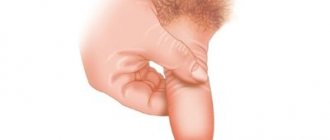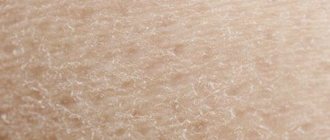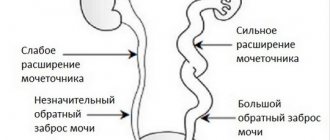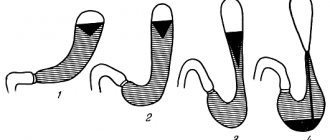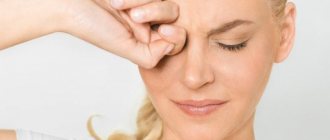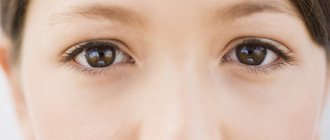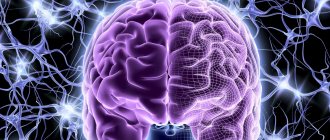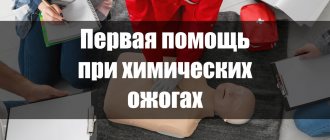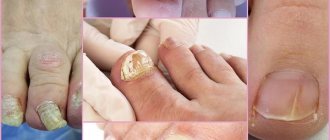Syndromes of lumbago disease 681
Dorsalgia of the lumbar spine is a pain syndrome that can be caused by the development of various diseases. Vertebrogenic dorsalgia of the lumbar region most often accompanies osteochondrosis in the acute stage. Muscular-tonic pain syndrome can be associated with curvature of the spinal column, inflammatory processes in internal organs, intoxication, poisoning with heavy metal salts, injuries, etc.
Dorsalgia of the spine always causes a lot of suffering to the patient, and treatment is usually lengthy and requires effort on the part of the doctor and the patient. In most cases, doctors pay attention only to symptomatic therapy. Non-steroidal anti-inflammatory drugs, muscle relaxants and other painkillers are prescribed. It is important to understand that they do not have a therapeutic effect, but only successfully mask pain, which is an SOS signal sent by the body. It is necessary to treat the disease that caused dorsalgia, and not the consequences.
We will tell you how to correctly diagnose and treat this condition in this article. Here we consider only the most effective methods of treating those diseases that can provoke the appearance of pain in the back.
Etiology
Dorsalgia can be caused by many factors. Moreover, both related to disorders in the tissues of the back and not related to them. It is worth considering the causes of pain in the context of different groups of pathologies.
Pathologies of the spinal column:
- osteomyelitis - bone marrow disease;
- osteochondrosis - destruction of intervertebral discs with pinching of nerve endings;
- osteoporosis - increased fragility of bone tissue;
- benign and malignant neoplasms;
- protrusion and hernia - protrusion of the core of the intervertebral disc beyond its bone ring;
- spinal canal stenosis - narrowing of the lumen in the spine through which the spinal cord passes, as a result of a hernia or the growth of osteophytes on the vertebrae;
- injuries of the spine and soft tissues of the back.
Muscle tissue diseases:
- Crick;
- myositis - weakening and atrophy of muscles as a result of injury, toxic poisoning, inflammation;
- muscle spasms - occur as a result of excessive stretching, pinching, and disruption of nutritional processes.
Dorsalgia can also develop as a result of diseases of internal organs: suppuration in the retroperitoneal space, diseases of the abdominal and pelvic organs, rheumatism, menstruation or pregnancy in women. Dorsalgia can occur as a short-term symptom after heavy lifting, hypothermia, prolonged stay in an uncomfortable position, or back injury.
Dorsalgia of the lumbosacral spine
Those patients who suffer from degenerative dystrophic lesions of the L5-S1 intervertebral disc know firsthand what dorsalgia of the lumbosacral region is. It accounts for the conditional center of gravity of the human body. When walking, running, or simply standing on your feet, this intervertebral disc is subjected to enormous pressure. Excess body weight increases this burden many times over.
If a person leads a sedentary lifestyle, has a sedentary job and does not engage in physical exercise, then his muscular frame of the back and lower back practically does not work. This negatively affects the condition of the intervertebral disc, since it does not have its own vascular network and can only receive nutrients through diffuse exchange with the surrounding muscle tissue. But diffuse nutrition is only possible if the muscles of the back and lower back are subjected to regular and sufficient physical activity.
Dorsalgia of the lumbosacral spine can develop against the background of the following diseases:
- osteochondrosis and its complications in the form of protrusion, extrusion and herniation of the intervertebral disc, instability and disturbance of vertebral statics;
- spondylosis and spondyloarthrosis with concomitant deformation of the intervertebral joints;
- piriformis syndrome and other types of pinching and inflammation of the sciatic nerve;
- Bechterew's disease and systemic lupus erythematosus;
- displacement of vertebral bodies;
- osteomalacia and osteoporosis;
- poor posture and curvature of the spinal column.
Dorsalgia of the lumbosacral spine with radiculopathy is often diagnosed, which causes unpleasant neurological symptoms. This may be numbness of the lower limb, buttock area or anterior abdominal wall. Paresthesia, crawling sensations, coldness and paleness of the skin also often occur. Muscle weakness and increased fatigue, decreased strength may be observed.
In such a condition, you should seek help from a neurologist as soon as possible. This specialist will be able to determine the source of pain and prescribe adequate and effective treatment.
Types of pain
Since dorsalgia is a broad concept, it is worth considering its types in terms of localization and intensity.
Classification by localization:
- thoracalgia - pain in the thoracic back;
- cervicalgia - unpleasant symptoms in the neck;
- lumbodynia - lower back pain.
Also, pain can be local - located in the area of the pathology itself, and diffuse - dispersed over a wide area of the back.
Classification of dorsalgia by duration and severity of symptoms:
- spicy. Severe pain that can bother a person for up to 3 weeks;
- chronic. It may be less severe than acute, but symptoms persist for more than 3 weeks. Often causes loss of capacity and disability.
Classification
Depending on the location of pain, there are the following forms of this syndrome:
- cervicalgia – has the second name “dorsalgia of the cervical spine”;
- lumbodynia - in this case, pain is localized in the lumbar area, which is why the disorder is also known as dorsalgia of the lumbar spine;
- Thoracalgia - differs in that the main symptoms do not extend beyond the sternum, which means that in such cases dorsalgia of the thoracic spine will be diagnosed.
Depending on the duration of expression of unpleasant sensations, the syndrome can occur in several forms:
- Acute dorsalgia is such if the pain bothers patients for no more than a month and a half. It differs in that it has a more favorable prognosis in comparison with the sluggish variety;
- chronic dorsalgia - diagnosed if pain in one or another part of the spine persists for more than twelve weeks. Such a course is fraught with loss of working capacity or disability of a person.
By origin, this violation has two types:
- vertebrogenic dorsalgia - characterized by the fact that it is directly related to injury or diseases of the spine;
- nonvertebrogenic dorsalgia - the occurrence of this type is caused by other etiological factors, for example, somatic ailments or psychogenic causes.
Symptoms
In general, dorsalgia can be described as back pain. But depending on its cause, the nature of the spasms and their localization may change, as well as other unpleasant manifestations.
Symptoms of dorsalgia in rheumatism:
- acute pain in the lower back, which can radiate to the hips, buttocks, one or both legs;
- spasm that occurs after a long stay in one position.
Symptoms of infectious dorsalgia:
- pain running through the entire length of the spine;
- focal pain in the lumbar, thoracic, cervical or coccygeal region;
- swelling and redness of the skin in the affected area.
Symptoms of muscular dorsalgia:
- an extensive focus of spasm in the right or left half of the body;
- the presence of pain points that can be felt when pressing on the back;
- increased discomfort with weather changes;
- attacks of muscle weakness.
Manifestations of osteochondrosis:
- a feeling of spasm in the back when staying in one position for a long time;
- aggravation of the condition with sharp bends or turns of the body;
- a feeling of complete numbness or “pins and needles” in the limbs;
- headaches and dizziness;
- deterioration in the quality of vision, hearing, and taste buds;
- weakness;
- partial paralysis of the limbs.
Also, other symptoms due to pathologies of internal organs are added to back pain. When kidney disease occurs, a person feels pain in the abdomen, a pulling sensation in the lower back, and a frequent urge to go to the toilet. Gastrointestinal diseases cause girdling pain, digestive problems, stomach cramps, and nausea after eating. Back pain can be a symptom of diseases of the genitourinary system. In men, this may be inflammation of the prostate; in women, diseases of the uterus and ovaries, or ectopic pregnancy.
Chronic discomfort
This type of pain is the most unpleasant. Chronic pain occurs due to changes in the intervertebral discs. At first this manifests itself in small tingling sensations when bending over, inhaling and exhaling. Then the patient increasingly notices discomfort. And finally, pain becomes a constant companion of a person.
Ankylosing spondylitis, or inflammation of the intervertebral joints, may be one of the reasons for its appearance. In order to successfully cope with chronic pain, you need to find out what causes it. Lumbar dorsalgia is characterized by the appearance of unpleasant sensations in the lumbar region. Physiotherapy and reflexology are some of the most effective methods for relieving chronic pain. Of course, this approach requires a lot of patience on the part of both the patient and the specialist, but it is worth it. By completing a full recovery course, you can achieve truly effective results.
Intervertebral discs have the ability to completely regenerate and return to normal. Chronic pain is not a death sentence. If you take therapy seriously and with full responsibility, then within a certain period of time the patient will feel much better.
Secondary dorsalgia
Secondary dorsalgia includes pain that is not associated with diseases of the spine. Secondary dorsalgia can be caused by severe stress. In this case, the person is under severe tension, which causes muscle spasms and circulatory problems. As a result, general malaise, chronic insomnia, and aches throughout the body may appear.
Improper and excessive physical activity leads to sprains and sometimes muscle tears. As a result, a person feels pain at rest; it can be sharp, spasmodic or aching. The pain also intensifies when bending and turning the body, or pressing on the injured area. With severe damage to soft tissue, hematoma and swelling form at the site of the injury.
Flat feet is a disorder of the structure of the foot, which results in improper distribution of the load on the legs and spine, which causes spasm.
A serious pathology such as an aortic aneurysm can cause back pain. If the disorder is localized in the thoracic region, the process of inhalation and swallowing becomes difficult, and the patient may suffer from coughing. If the pathology has developed in the lumbar region, swelling, a feeling of pulsation in the abdomen, fever, and aches throughout the body appear.
It is important to understand that both primary and secondary dorsalgia are just a symptom that may indicate different pathologies, related or not related to the tissues of the back.
Causes
The main cause of acute and regular back pain is stress . It is stress that causes muscle strain. Over the years, accumulated negative emotions that a person does not work with lead to the development of painful areas.
Another common cause of spinal problems is a sedentary lifestyle , which does not give the muscular system the necessary daily dose of movement.
Among the medical diagnoses leading to dorsalgia, doctors usually name:
- radiculitis;
- osteochondrosis;
- Bekhterev's disease;
- vertebral displacement;
- disc protrusion;
- intervertebral hernia;
- spondylosis;
- subluxations;
- scoliosis.
Diagnostics
If back pain causes severe discomfort and persists for more than 1 week, you should consult a doctor. It's worth starting by visiting a therapist. The doctor will conduct a survey, examination and prescribe additional examinations and tests.
For additional diagnosis of the causes of dorsalgia, the following methods are used:
- blood and urine tests;
- radiography - allows you to assess the condition of bone tissue;
- electromyography is a diagnostic technique for assessing muscle condition;
- densitometry - assessment of bone tissue density if osteoporosis is suspected;
- osteoscintigraphy - x-ray examination with the introduction of a contrast agent into the joint cavities;
- Ultrasound of internal organs - performed if secondary dorsalgia associated with diseases of the gastrointestinal tract, kidneys or genitourinary system is suspected;
- CT and MRI are the most informative techniques that allow you to assess the condition of all tissues of the body. Used when there is a vague picture of disease symptoms.
Based on the results of the examination, the therapist will be able to refer you to a specialist: an orthopedist, neurologist, vertebrologist, urologist or gynecologist.
Characteristic manifestations of oncology
Ossalgia is an obligatory companion to cancer diseases that affect bone tissue. The pain becomes more intense as the disease progresses. In the early stages of the disease, pain is felt only after physical activity and at night. Over time, the pain becomes permanent.
With cancer, the likelihood of fractures also increases significantly. You need to pay attention to this. Often, patients experience the fact that they develop fractures even with minor trauma.
Even leaning on a sore leg can lead to a fracture.
This is due to weakening of bone tissue by oncology.
Treatment
Therapy for the presence of dorsalgia involves a whole range of procedures. This includes taking medications, using special support corsets, physiotherapy, massage and physical therapy. It is a mistake to believe that bed rest is an effective way to eliminate dorsalgia. Rest is indicated for the patient only in the first 2-3 days after the onset of the symptom. In the future, immobilization can cause complications. A long stay in a supine position causes a reduction in muscle volume and strength, a decrease in vascular tone, and a lack of minerals in the bones.
Drug therapy
Drugs for the treatment of dorsalgia are used only as prescribed by a doctor. First of all, painkillers are used. They can be prescribed as ointments, tablets or injections. If the pain is unbearable, a paravertebral block can be performed - an injection of an anesthetic into the intervertebral lumen. Allows you to relieve pain in the spine for several weeks. Also for treatment, drugs are prescribed that stimulate blood circulation, strengthen bone and muscle tissue, reduce swelling, and strengthen the immune system. Additionally, the patient can take sedatives that will help relieve stress and normalize sleep disturbed as a result of constant discomfort.
Physiotherapy
To normalize blood circulation, relieve painful spasms, and reduce swelling, electromyostimulation, magnetic therapy, acupuncture, and quartz treatment are prescribed.
Electromyostimulation is a forced contraction of muscles using microcurrent discharges.
Magnetotherapy is the effect of two magnets on tissues, which, due to the force of resistance, provide micromassage at a depth of up to 6 cm, which cannot be achieved by other methods.
Acupuncture is an oriental technique of influencing biologically active points on the body using thin needles. Stimulation at the right points activates nerve endings that transmit a signal to the affected organ, where natural recovery processes begin.
Quartz treatment is the effect of a special ultraviolet lamp on the body, under the rays of which the exchange of calcium and phosphorus in tissues is accelerated, pathological microorganisms are destroyed, and immunobiological processes are activated.
What dorsalgia can mean and how to determine the causes of real pain:
Support corsets
This is a system made of durable, elastic fabric with stiffening ribs. Designed to correct posture and relieve stress from the spine. Corsets vary in shape and purpose. Presented separately for the cervical, thoracic and lumbar regions. They are fixed using elastic bands and fasteners, and the stiffening ribs ensure that the back is maintained in an anatomically correct position. At this time, the load is removed from the spasming muscles, which helps relieve pain. Wearing a corset is prescribed by a doctor and carried out in courses.
Massage
Manual therapy is one of the most effective remedies for dorsalgia. Massage can be performed both in specialized centers and at home. But before carrying out it, it is important to make sure that the negative symptoms were not caused by inflammation, neoplasms or infectious pathologies. In such cases, massage is contraindicated.
The massage technique for dorsalgia is selected depending on the location and cause of the pain. If the source of the problem is osteochondrosis, the cervical-collar area is treated; in case of disturbances in the thoracic region, this area, as well as the patient’s chest and abdomen, are massaged. If there are pathologies in the lumbar region, massage this area, as well as the tailbone, buttocks and legs. During the massage, it is important not to impact the spine. In the presence of osteochondrosis, scoliosis, arthrosis and other pathologies of bone tissue, the vertebrae can be displaced and partially destroyed. In this case, pinching of nerves and blood vessels occurs, and manual intervention can only aggravate the pathology.
Exercise therapy
Therapeutic exercise is the basis of conservative treatment. Correct execution of exercises allows you to relieve muscle spasms, improve the condition of intervertebral discs, and normalize blood circulation in the back. An important rule when performing exercises is smoothness, no sudden movements and a gradual increase in load.
Exercises:
- Stand straight, hands at your sides, feet shoulder-width apart. Raise your arms to the sides and gradually stand on your tiptoes as you inhale. Stretch your arms up, stretching your back muscles. Lower your arms as you exhale.
- Lie on your back with your knees slightly bent. Place your right hand behind your head, move your legs to the left so that your left leg lies on the floor and your right leg lies on top. At the same time, turn your head in the opposite direction. Do it both ways.
- Bend your legs under you, sit on your heels, place your hands on your knees in front of you. Arch your back, turn your shoulders forward, feel the muscles stretch. Then arch your back in the opposite direction, pull your shoulders back, open your chest as much as possible, and stretch your neck. Repeat several times.
- Get on all fours, spread your arms and legs shoulder-width apart. Sit on your heels so that your palms remain in the same place, place your stomach on your knees, and lower your head. At this time, the back muscles are stretched.
- From a position on all fours, jump your feet back slightly and stand on your toes. Then lift your pelvis so that your legs are straight and your torso and arms form a straight line. As a result, the body is bent only in the pelvic area. This yoga pose is called Downward-Facing Dog. Bend your back as much as possible at the shoulder blades so that your body and arms are as straight as possible. Hold for a couple of seconds.
- From the previous position, lower your pelvis down, lift your head up, bend your back. In this pose, you fix your body on outstretched arms and toes, while your legs and pelvis do not touch the floor. From this position, return to Downward-Facing Dog.
- A simple exercise will help with neck pain. To do this, place your palm on your forehead, press with your hand, and resist with your head. At this time, you should feel the muscles on the back of your neck tense. Pressure should be applied at approximately ⅓ of maximum effort. Repeat the same with your palm alternately on the temples and the back of the head. This simple technique helps relieve muscle spasms that you might not have noticed due to being in one position for a long time, for example, sitting at a desk at work.
Do not make sudden movements during therapeutic exercises. If you feel pain and discomfort, avoid some exercises or take a break from training.
Surgical treatment
Surgery for dorsalgia is prescribed in extreme cases when complex, irreversible disorders have appeared in the structure of the spine. Different methods are used for this:
- discectomy. Removal of the intervertebral disc along with the hernia formed on it;
- electrical stimulation. Installation of a special implant that blocks pain using electrical impulses;
- spinal fusion. Removal of deformed fragments of the spine.
Surgical techniques completely relieve the patient of pathology. But in the future, the body requires utmost attention, regular implementation of supportive treatment procedures, and abstaining from overexertion. Often the operation performed becomes a reason for assigning disability.
Prevention
In order to never encounter dorsalgia or to reduce its manifestations in the presence of pathologies, you should adhere to simple rules:
- ensure correct posture;
- If you notice back pain, consult a doctor immediately;
- if you have a sedentary job, take short breaks to warm up every hour;
- replace the mattress with an orthopedic one, the pillow should be small and moderately hard;
- avoid hypothermia;
- Don't lift weights. If this cannot be avoided, use a support corset and keep your back straight while lifting so that the load falls on your legs;
- normalize your weight;
- diversify your diet, include foods rich in calcium;
- Exercise regularly and take massage courses.
These are simple recommendations that are suitable for everyone, regardless of age and health status. Compliance with them will help maintain the normal condition of the spine.
What kind of disease is this?
Dorsalgia syndrome is the presence of pain in any part of the back. This is not a separate disease, but a complex of symptoms that can bother people at any age and regardless of gender.
The provoking factor is the course of any disease associated with the spine. The signs will depend on the pathology that became the source of dorsalgia.
